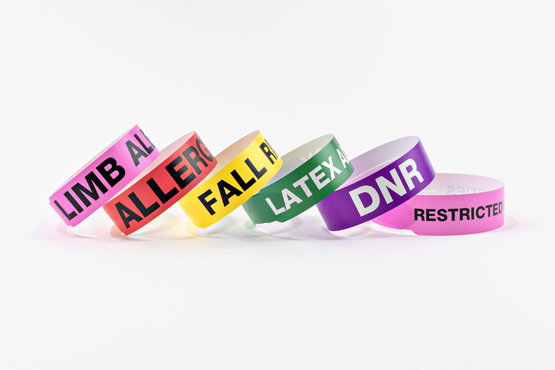Discovering the Numerous Types of Patient Identification Band Utilized in Medical Facilities
In the intricate globe of health care, the critical duty of Patient Identification bands commonly goes unnoticed. These bands, varying from simple paper wristbands to advanced RFID bands, create the backbone of Patient safety and security methods, making sure precision in Patient Identification. Yet, the substantial variety of these bands, each with its distinct benefits and constraints, is frequently ignored. As we navigate through this topic, one may get insight right into the refined intricacies and important relevance of such bands in medical centers.
Comprehending the Relevance of Patient Identification Bands
While they might look like mere accessories, Patient Identification bands play a vital function in clinical centers. These bands function as an important tool for verifying Patient identification, avoiding clinical errors associated to misidentification. The bands commonly display necessary information such as the Patient's name, age, blood kind, and any kind of known allergic reactions. They permit health care professionals to rapidly access this vital information, thereby helping with exact and punctual clinical therapy. Patient Identification bands additionally help in streamlining administrative tasks, guaranteeing exact record-keeping and payment. Regardless of their simplicity, these bands personify the concept of Patient security, a foundation of high quality healthcare. Without them, the danger of medical errors, and as a result, Patient damage, may dramatically raise.
Standard Paper Wristbands: Their Usage and Limitations
Traditional paper wristbands have actually been a staple in Patient Identification throughout different medical centers. While their usage is widespread, they nurture specific constraints that may influence their performance in Patient monitoring. This area will focus on the extent of their application and the fundamental drawbacks related to their use.
Paper Wristbands: Use Scope
In the world of Patient Identification, paper wristbands have actually long held a critical function. These bands are usually used in outpatient setups, where the Patient's remain is short-term. The wristbands have vital information such as the Patient's name, day of birth, and a special Identification number. This easy, yet reliable system, enables clinical experts to promptly and accurately recognize patients, making sure the correct therapy is carried out. Paper wristbands are likewise made use of in emergency circumstances, where quick Identification is paramount. Their use includes events like blood contribution drives and mass inoculation programs, even more emphasizing their convenience. Regardless of innovations in technology, the humble paper wristband continues to be a cost-efficient and reliable remedy for Patient Identification in different medical care scenarios.
Limitations of Paper Wristbands
In spite of their extensive usage, paper wristbands are not without their disadvantages. Their physical toughness is just one of the considerable restrictions. Direct exposure to water, sweat, or misuse can make them unreadable and even create them to degenerate. In enhancement, paper wristbands often do not have the technical capacities of more contemporary alternatives, such as barcoding or RFID chips, limiting their functionality to merely presenting composed information. The inability to upgrade or change the data on the wristband is another shortcoming. Moreover, if the information is transcribed, readability can be compromised, bring about possible misidentification. Lastly, paper wristbands can cause pain or skin inflammation to some patients, specifically when used for extended durations.
Barcoded Wristbands: Advancements in Patient Identification
While Patient Identification has actually long been a critical element of medical care, the introduction of barcoded wristbands signifies a considerable jump forward. These bands leverage the simplicity of barcoding modern technology, permitting for Patient info to be rapidly checked and accessed. They boost the rate and precision of Patient Identification, decreasing the risk of medical errors related to misidentification.
Radio Frequency Identification (RFID) Bands: an Action In The Direction Of Futuristic Health Care
The development of Patient Identification bands has caused the appearance of Radio Regularity Identification (RFID) Bands (patient identification band). These ingenious devices present vital benefits for health care facilities, offering an extra effective and technically advanced methods of Patient Identification. The execution of RFID in health care is a considerable step in the direction of a much more futuristic approach to Patient administration and safety
Recognizing RFID Bands

RFID Bands: Key Benefits
Largely, these bands improve Patient safety and security by providing precise, rapid Identification, consequently reducing medical mistakes. RFID bands can save a vast amount of Patient data, consisting of clinical history and allergies, allowing individualized treatment. Overall, RFID bands represent a considerable innovation in Patient Identification technology, profiting both people and healthcare companies.
Executing RFID in Healthcare
As we enter a highly innovative period, the execution of RFID bands in medical care comes to be significantly essential. These bands provide a smooth means to track and recognize people, guaranteeing their safety and boosting performance in therapy procedures. RFID bands supply countless benefits over traditional Identification techniques. They can save a substantial quantity of data, including the Patient's case history and therapy strategies, which can be quickly accessed by health care service providers. This data helps physicians make notified choices relating to the Patient's treatment strategy. Additionally, RFID bands minimize medical mistakes by providing exact Patient Identification, which is essential in stopping misdiagnosis or wrong medicine administration. Thus, the execution of RFID bands is a significant action towards boosting Patient safety and security and health care delivery.

Color-Coded Wristbands: Aiding in Quick and Accurate Medical Diagnosis
In the dynamic setting of a medical facility, color-coded wristbands have actually become crucial tools for swift and precise Identification of a person's clinical condition. These wristbands, worn by patients, lug particular colors that correspond to various clinical conditions or standings. For circumstances, red might indicate allergic reaction dangers, while yellow may signify a loss danger. This system is created to provide immediate aesthetic hints to health you could try here care carriers, improving Patient safety and security and care high quality. In emergency scenarios, making use of these wristbands enables quick decision-making. Nevertheless, the effectiveness of color-coded wristbands relies on the harmony of color analysis across medical care organizations, requiring typical standards for regular application.
Strategies for Reliable Implementation and Monitoring of Patient ID Bands
Accomplishing optimum use of Patient Identification bands demands a well-structured technique for their execution and administration. The very first action involves training all wellness personnel on the significance of properly using and reviewing these bands. Medical facilities must systematize the usage of ID bands throughout all departments, guaranteeing uniformity and minimizing disparities. Normal audits should be conducted to confirm adherence to policies and to correct any type of incongruities. Patient education is also critical; clients need to understand the objective of the bands and the need for their consistent wear. patient identification band. Finally, it's important to have a backup strategy in position, such as barcode scanning or see this page biometrics, to guarantee that Patient Identification is never ever compromised.
Final thought
Patient Identification bands are critical in clinical centers to guarantee safety and accuracy. Typical paper, barcoded, RFID, and color-coded wristbands each hold distinct benefits, ranging from cost-effectiveness to sophisticated information storage and instantaneous medical informs. Effective application and monitoring of these bands can considerably lower medical errors, enhance efficiency, and enhance total Patient care. Therefore, understanding and making use of these Identification tools is extremely important for maintaining high requirements in medical care.
These bands, differing from simple paper wristbands to advanced RFID bands, develop the backbone of Patient safety procedures, making sure accuracy in Patient Identification.The advancement of Patient Identification bands has actually brought regarding the appearance of Radio Regularity Identification (RFID) Bands. On the whole, RFID bands stand for a substantial advancement in Patient Identification modern technology, profiting both individuals and healthcare suppliers.
RFID bands lower clinical mistakes by offering precise Patient Identification, which is important in stopping misdiagnosis or wrong medication administration. Patient education and learning is likewise vital; individuals need to comprehend the objective of the bands and the requirement for their continuous wear.
Comments on “Why a Patient Identification Band is Essential in High-Volume Environments like Emergency Rooms”